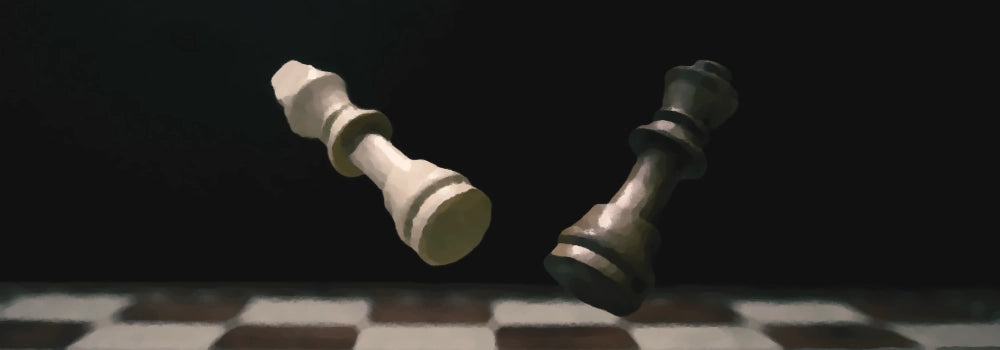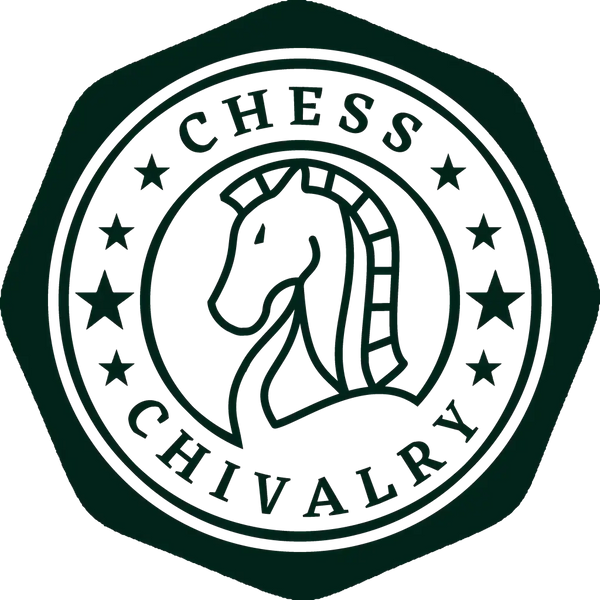
Chess & Tactics: Trading Chess Pieces
Share
Trading chess pieces can give you advantages or disadvantages depending on the game situation. Sometimes a seemingly obvious blow to an opponent's chess piece is not what it appears to be. Other times, a false move by the opponent reveals a great opportunity to win the game outright. Regardless of the game situation, the offensive style of play requires an accurate assessment of the chances and risks as well as a good strategic and tactical understanding. But what criteria can be used to judge these situations? Not every player is a chess grandmaster who can calculate a large number of moves in advance, or a club player who can look back on several years of experience in a competitive environment. Let's take a look at this chess set-up.

This example shows a game situation in which a black knight has set up a threat against the white rook. The question now is, how does White react? Attack with your own knight? Attack with the bishop? Or withdraw the rook? The solution to this chess puzzle can be found at the end of the article.
But to give you a little help, I'll give you a few rules of thumb below that will make the decision-making process a little easier and hopefully give you a new perspective on your tactical options.
Basically, there are five approaches you can use to make an assessment and a decision to exchange pieces.
Method 1: Assess the Material Value of Your Pieces
The material value is a value model based on a point system, which easily measures both individual values of chess pieces and the total value of all chess pieces of a player. According to the system, all chess pieces have a value based on the equivalent of a pawn. Here is an overview:
- Pawn: 1
- Knight: 3
- Bishop: 3
- Rook: 5
- Queen: 9
- King: ∞
With eight pawns, two knights, two bishops, two rooks and a queen, a player has a total material value of 39 points on his side of the board. The king is not counted, as he cannot be traded. From the above values, it is easy to see that you gain material by capturing the higher-value pieces with lower-value pieces. You still have to take into account your opponent's tactical motive. But most missteps in chess are made by false moves that result in trading pieces of unequal value. So look at the material value of your trading pieces and the material value of your opponent's pieces. Be careful, however, that you do not blunder and that your apparent material gain does not lead to a piece position that is unfavourable for you. Capturing by material value is the simplest method of assessing attack potential. Of course, you should know the values of the pieces by heart, regardless of your intention to trade off pieces.
Method 2: Calculating the Sequence of Moves
An obvious, albeit error-prone, method is to calculate the direct consequences of exchanging pieces if several pieces on a square are captured in succession. Go through all the pieces involved in the trading one by one, making sure that you do not trade one pieces more than your opponent. Be careful that your position is not weakened and that your opponent has to adapt his tactics to your attack. Don't exchange just for the fun, but with the concrete intention of keeping the initiative in the next moves. To do this, always think about a follow-up attack - ideally on a weak pawn or at least on a weak square in the opponent's half. Chess puzzles are a good way to practise calculating through, but you should also acquire a tactical understanding to interpret patterns in chess. Because there is a big problem with chess puzzles: during the puzzle you know that there is a special move that you have to spot. In a real game, however, nobody tells you when such an extraordinary move is possible. So play as many games as possible and analyse them afterwards. Platforms like www.lichess.org offer you all the tools you need to gain insights from your previous chess games. In addition, Lichess has a large database of so-called studies. In these, other players explain specific game situations or chess openings and show you what you need to pay attention to. Take a look, it's worth it.
Method 3: Evaluate the Activity of the Chess Pieces
Active chess pieces are worth more than passive chess pieces. Of course, a rook is worth more than a knight. But withdrawing your knight from a strongly contested centre only to capture a rook far away from the action can be equivalent to a material sacrifice.The rook might never have found its way into the game, while your knight, however, was actively exerting pressure on the opposite side. On the other hand, it can be advantageous to capture an opponent's bishop on the same colour as your rooked king early on.

In this example the white knight on a4 is inactive, since it cannot jump to a safe square. According to the material value Black is inferior, but since the white knight cannot contribute its value and Black has actively positioned his pieces, Black is on the winning side here.
Assess the tactical value of the moving chess pieces. The opponent has an active knight, which is centred, well covered and targets weak squares? You have a bishop that is partially blocked on the base row, but can capture the knight? If your bishop is not tactically planned otherwise, this attack can hit your opponent hard and open up new options for you. Another example could be that you cover and defend a certain square colour well with your pawn structure. In this case, the value of the opponent's bishop of the same square colour would drop sharply and you could concentrate on capturing other pawns. In this case, however, make sure that your own bishop is not itself blocked by your pawn structure.
Method 4: Evaluate the Space on the Chessboard
If you are under pressure and your opponent can use a larger space on the chessboard for his attacks, his losses of chess pieces weigh more than yours. This is because your pieces usually impede each other in a smaller space and cannot develop their full potential. The situational material value of your chess pieces is lower, while your opponent's material value is higher due to better attacking options. You could also say that you have less to lose. Therefore, trade off your chess pieces if you need to gain space and want to change your defensive stance into an offensive style of play. However, be careful not to simply attack across the board and consider whether capturing a piece really messes up your opponent's tactics. Also note that bishops, because of their long range, are less likely to block and thus become stronger when the board is cleared, while knights increasingly lose their advantage of jumping over for the same reason. Depending on the situation, it can therefore make sense to exchange your knights for your opponent's bishops as the game progresses. Pawns also gain in importance. If they are still rather cannon fodder in the first half of the game, they can quickly outnumber your pawns in the endgame and develop into queens at the end of the board. So pay attention to your pawn structure early on if a tough battle is looming.
Method 5: Assess the Direct Consequences for You and Your Opponent
There are game situations in which capturing pieces should always be done. One is the direct threat of mate and the other is a material advantage.
The Direct Mate Threat
If your opponent threatens to mate your king in the next move and you can avoid this by attacking, capturing is unavoidable - even if this puts you in a worse position.

In the example, the black queen threatens mate with a move to g2. White is forced to capture with his queen, which is then taken out of play by the opponent's knight from f7. Black gains an even more active position on top of his already existing material advantage.
Even though in many cases such a game situation could result in the loss of the game either way, you should not give up immediately. A clever move can still be made from a worse position.
The Material Advantage
If you have more material than your opponent (in total or in comparison, more valuable pieces), then it is advisable to capture pieces of at least equal value whenever possible. This means that your opponent's tactical possibilities are more impaired than your own, since he can play less interplay with his pieces as a result. Although you yourself have fewer options, since you also lose a piece, the benefit does not decrease linearly. For the player with less material, a further loss weighs more and more heavily, since the imbalance in material value makes it increasingly difficult for him to compensate.
I hope that I have been able to explain the five concepts to you in a good and understandable way and that you have gained an advantage for your style of play. The explanations given here refer primarily to the offensive trading of pieces. However, there will also be situations like in the initial example, where the opponent attacks you and the trading takes place in your defensive position. Always make sure that you protect your pieces or that they don't hang. In this way you will not be under pressure and can more easily take the initiative yourself. The following is the solution to the example:

We capture with our bishop on d4, whereupon it is captured by the black c5-pawn. Why? Our bishop, unlike our knight, was inactive and blocked by our own pieces, while the opponent's knight had actively set up a threat. Moreover, the black pawn at the end of the capture sequence closes the line of the d8-rook, which impairs the attacking potential of this heavy piece. Now we have the opportunity, for example, to move our knight to a5 in order to put pressure on the bishop on b7 and perhaps initiate a flank attack on the b-line with our two rooks.
Still not enough about chess strategies and chess tactics? Have a look at the situations of a pin, a fork and a skewer, which are explained on my page further down in the rulebook. These will help you to create favourable situations for trading or defending yourself against clever attacks by your opponent. Also study chess openings intensively. These decide the actual course of the game early on and also tell you which early moves are sensible and, above all, which you should refrain from in order not to get into trouble. In addition, chess openings also offer you the advantage of being able to better assess the material value of the chess pieces in relation to the specific game situation and thus make better decisions.
If you have any further questions, please feel free to contact me via my contact form.
Besides my chess blog I also offer a wide range of Staunton chess pieces and chess sets.
I wish you a lot of fun in the game, much success and rapid progress in your learning.
See you soon.
Stefan
